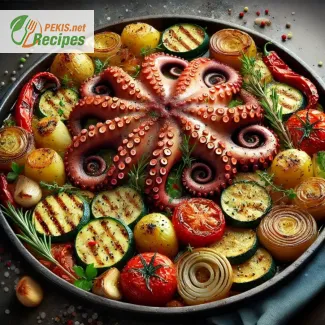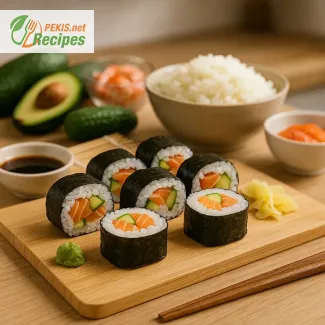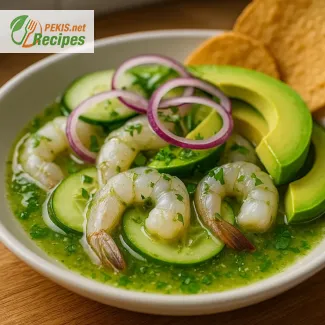
Oven-Baked Octopus with Vegetables is a Mediterranean delicacy that brings together the rich flavors of tender octopus and vibrant vegetables, slow-roasted to perfection. This dish is a beautiful balance of oceanic taste and earthy undertones, combining the soft, juicy texture of octopus with the natural sweetness of seasonal vegetables. Popular along the coastal regions of the Mediterranean, baked octopus offers a unique culinary experience, ideal for those seeking a healthy yet flavorful meal that satisfies on every level.
One of the most appealing aspects of oven-baked octopus is its simplicity and elegance. While octopus can be challenging to prepare, baking it ensures that it remains tender and flavorful, unlike traditional boiling methods that can make it rubbery if not monitored closely. By slow-cooking octopus in the oven, it transforms into a soft, melt-in-your-mouth delight. This approach also allows the juices of the octopus to blend seamlessly with the surrounding vegetables, creating a naturally rich, umami-filled broth that permeates each ingredient.
The vegetables play a crucial role in this dish, providing both color and complementary flavors. Traditionally, oven-baked octopus is cooked with potatoes, carrots, bell peppers, red onions, and garlic. These vegetables soak up the juices of the octopus as they roast, creating a depth of flavor that is savory and slightly sweet. The potatoes add heartiness to the dish and offer a creamy contrast to the firm texture of the octopus, while carrots and bell peppers bring a natural sweetness that balances the briny taste of the seafood. Meanwhile, red onions and garlic infuse the dish with a pungent aroma, which elevates the overall flavor profile and complements the delicate taste of octopus perfectly.
A key to unlocking the full potential of oven-baked octopus is the use of fresh herbs and spices. This dish is typically seasoned with rosemary, thyme, bay leaves, and a sprinkle of sea salt. Each herb brings its unique aroma: rosemary adds a piney, slightly woody note that pairs well with the seafood, while thyme introduces a subtle earthiness that complements the roasted vegetables. Bay leaves, often used in Mediterranean cuisine, add depth and warmth to the dish, enhancing the natural flavors without overpowering them. To finish, a drizzle of extra virgin olive oil ties everything together, adding a fruity, rich flavor that enhances the entire dish.
For a touch of acidity and brightness, fresh lemon slices are often placed on top of the octopus before baking. The lemon not only balances the richness of the olive oil but also enhances the flavor of the octopus, adding a citrusy layer that cuts through the other flavors, making each bite feel lighter and more refreshing. Some chefs even add a splash of white wine to the baking dish, which brings an additional layer of complexity and sophistication to the dish. As the wine reduces, it melds with the juices from the octopus and vegetables, creating a flavorful base that ties everything together.
In addition to being delicious, oven-baked octopus with vegetables is a highly nutritious dish. Octopus is a lean source of protein that is rich in essential nutrients such as vitamin B12, iron, and omega-3 fatty acids. These nutrients support heart health, improve brain function, and contribute to a balanced diet. The vegetables add valuable vitamins and minerals, such as vitamin C from bell peppers and potassium from potatoes, making this dish not only a culinary delight but also a nutritious choice for those aiming to eat well without compromising on flavor.
Moreover, this dish is perfect for a variety of dietary needs. As it is naturally gluten-free, it caters to those with gluten sensitivities or allergies, and if extra virgin olive oil is used in moderation, it can also be considered a low-fat option. Its wholesome ingredients make it suitable for those following the Mediterranean diet, which emphasizes whole foods, healthy fats, and plant-based ingredients, all of which are present in this beautifully balanced dish.
Serving Suggestions: Oven-baked octopus with vegetables is a versatile dish that can be served as a main course or as part of a larger Mediterranean-inspired spread. It pairs wonderfully with a crisp, dry white wine, such as Sauvignon Blanc or Pinot Grigio, which complements the seafood's light, briny flavors without overshadowing them. For an authentic Mediterranean experience, you may also serve it with a side of crusty bread, perfect for soaking up the delicious juices that collect in the baking dish.
Overall, oven-baked octopus with vegetables is a dish that celebrates the flavors of the Mediterranean in all their simplicity and depth. It’s an excellent choice for special occasions or for any day when you want to bring the taste of the sea into your home. The combination of octopus, fresh vegetables, herbs, and olive oil results in a meal that is both delicious and healthful, a true reflection of Mediterranean culinary traditions. Perfectly suited for food lovers seeking a unique seafood experience, this recipe is one that will impress family and guests alike, offering a memorable taste journey with every bite.
- Prepare the Octopus: If using frozen octopus, thaw completely. Rinse the fresh octopus briefly under cold water to remove any impurities. To tenderize the octopus, blanch it in boiling water for a few minutes or freeze it for at least one day beforehand, which helps to soften its muscle fibers.
- Prepare the Vegetables: Peel and cut the potatoes into wedges, slice the carrots, and cut the peppers into strips. Slice the red onion. Arrange all the vegetables in a large baking dish, spreading them out evenly.
- Season the Vegetables: Add the minced garlic, rosemary sprigs, thyme sprig, and bay leaves to the vegetables. Sprinkle with salt and pepper to taste, and drizzle with 2 tablespoons of olive oil. Toss the vegetables to ensure even coating.
- Add the Octopus: Place the octopus on top of the seasoned vegetables. Lay lemon slices over the octopus, then drizzle with the remaining 2 tablespoons of olive oil and pour in the white wine.
- Bake: Cover the baking dish with aluminum foil to lock in the moisture. Place in a preheated oven at 180°C (350°F) and bake for about 90 minutes. Remove the foil for the last 10–15 minutes of baking to allow the octopus and vegetables to brown slightly and develop a crispy edge.
- Serve: When done, remove the baking dish from the oven, cut the octopus into smaller pieces, and serve with the roasted vegetables, rich with Mediterranean flavors.
Tips and Techniques for Enhancing Oven-Baked Octopus with Vegetables
1. Preparing the Octopus
The proper preparation of octopus is essential to achieving a tender, melt-in-the-mouth texture. If you are using fresh octopus, it’s advisable to freeze it for a day before cooking. Freezing breaks down the muscle fibers, making the octopus softer when baked. Thawing a frozen octopus carefully also helps maintain this texture. If you don’t freeze it, blanch the octopus briefly in boiling water with a bay leaf, lemon, or a touch of salt. This short blanching process tenderizes the meat, allowing it to retain juiciness during baking and avoiding any rubbery texture that can arise from incorrect preparation.
2. Choosing Vegetables for Richer Flavor
The vegetables used in oven-baked octopus, such as potatoes, carrots, bell peppers, and red onions, create a flavorful bed for the octopus while providing different textures. Potatoes, for example, are rich and satisfying; they complement the lean protein in the octopus. Carrots and bell peppers add a natural sweetness that balances the briny notes of the seafood. For a more diverse flavor profile, try adding zucchini, cherry tomatoes, or fennel. These ingredients bring additional Mediterranean elements and flavors that work well with seafood. Cherry tomatoes, for instance, release juices as they bake, creating a slightly acidic base that enhances the octopus’s flavor.
3. Fresh Herbs for an Authentic Mediterranean Flavor
Herbs like rosemary, thyme, and bay leaves are foundational in Mediterranean cuisine and play an important role in oven-baked octopus. Fresh rosemary lends a woody, pine-like aroma that enhances the seafood, while thyme adds an earthy, slightly minty flavor that pairs well with roasted vegetables. Bay leaves bring a subtle bitterness and depth. For an even richer herbaceous profile, try adding fresh oregano or sage, both of which offer warm, savory flavors that enrich the dish. A final sprinkle of chopped parsley before serving provides a refreshing finish and vibrant color that complements the baked flavors.
4. Balancing the Acidity with Lemon and White Wine
Lemon slices are traditionally used to add brightness and cut through the richness of the olive oil and seafood. Place lemon slices directly over the octopus before baking to infuse it with a subtle citrus aroma. Additionally, a splash of white wine in the baking dish contributes acidity and depth to the flavors, helping to tenderize the octopus as it bakes. The wine reduces as it cooks, combining with the juices from the octopus and vegetables to create a delicious, slightly tangy broth. For a non-alcoholic option, substitute the wine with vegetable or seafood stock to maintain the depth of flavor without altering the dish’s essence.
5. Olive Oil Quality and Usage
Extra virgin olive oil is an essential ingredient in oven-baked octopus, lending the dish a smooth, slightly fruity flavor and a velvety texture. Olive oil also serves as a medium that enhances the overall flavor by locking in moisture as the octopus and vegetables cook. Be generous with olive oil, as it not only prevents the dish from drying out but also contributes a subtle richness. If you’re out of olive oil, opt for grapeseed or avocado oil, which has a mild flavor that won’t overpower the seafood. However, to preserve the authentic Mediterranean flavor, olive oil is the ideal choice.
6. Cooking Techniques for Maximum Tenderness
Octopus can be difficult to get just right; it becomes tough if overcooked and rubbery if undercooked. Covering the baking dish with foil during cooking is a technique that creates a steaming effect, allowing the octopus to tenderize slowly without losing its juices. For added flavor, you can first sear the octopus briefly in a hot pan with a drizzle of olive oil before placing it in the baking dish. This initial searing locks in the flavors and adds a slight caramelization, enhancing the taste and appearance of the final dish.
7. Enhancing Flavor with Additional Spices
While salt and pepper provide the basic seasoning, you can elevate the flavor with additional spices. Adding a pinch of smoked paprika or cayenne pepper to the seasoning mix brings a hint of smokiness and heat. Smoked paprika adds depth, while cayenne pepper provides a gentle kick that complements the dish without overpowering the octopus. Garlic powder or chili flakes are also excellent additions for those who prefer a spicier version. Adjust the quantity according to taste, as these spices can quickly overpower the dish if used excessively.
8. Allergy and Gluten-Free Adjustments
This dish is naturally gluten-free, but be mindful of the other ingredients if serving guests with allergies. For a completely allergen-free version, omit ingredients like wine, which may cause sensitivity in some individuals, and replace it with a suitable alternative. Octopus is a known allergen, so for guests with seafood allergies, you can substitute it with jackfruit or cauliflower. These plant-based options absorb the seasonings and flavors well, providing a similar texture and taste experience.
9. Serving Suggestions and Presentation Tips
Oven-baked octopus with vegetables makes an elegant main course but can also be presented as part of a Mediterranean spread. For a polished look, slice the octopus into smaller pieces and arrange them over the roasted vegetables. For an added touch, drizzle a bit of olive oil on top before serving. A garnish of fresh parsley or lemon zest brings an extra burst of flavor. This dish pairs beautifully with a crisp white wine or sparkling water with lemon to keep the flavors fresh and clean.
10. Storing and Reheating Leftovers
This dish can be refrigerated for up to two days if stored in an airtight container. When reheating, drizzle a bit of extra olive oil to keep the octopus and vegetables from drying out. Reheat in the oven at a low temperature, around 150°C (300°F), to maintain the tenderness of the octopus without overcooking it. Avoid microwaving, as it can make the octopus rubbery and cause the vegetables to lose their roasted texture.
11. Nutritional Benefits
Oven-baked octopus with vegetables is rich in nutrients and low in calories, making it an ideal choice for a health-conscious meal. Octopus provides a lean source of protein, packed with Vitamin B12, iron, and omega-3 fatty acids, which promote heart health and cognitive function. The vegetables add essential vitamins and minerals: potassium in potatoes helps regulate blood pressure, while vitamin C from bell peppers boosts the immune system and protects skin health.
12. Antioxidant Properties and Health Benefits
Several ingredients in this dish provide powerful antioxidants that benefit overall health. Vitamin C in bell peppers and lemon acts as a strong antioxidant, reducing oxidative stress and supporting the immune system. Extra virgin olive oil, rich in polyphenols, contributes to heart health and helps to reduce inflammation. Additionally, quercetin in onions supports healthy metabolism and may help reduce inflammation, adding to the dish’s numerous health benefits.
13. Versatility for Different Occasions
Oven-baked octopus with vegetables is versatile enough to suit various occasions, whether you’re hosting a dinner party or preparing a simple family meal. Its unique blend of flavors and textures makes it ideal for celebrations or special occasions. The dish’s nutritional benefits also make it suitable for regular meals, especially for those looking to incorporate more seafood and vegetables into their diet without sacrificing flavor.
14. Ingredient Substitutions for New Flavor Profiles
For a twist on the traditional recipe, consider adding Mediterranean-inspired ingredients like olives or capers, which bring a salty punch to the dish. Additionally, replacing part of the potato with sweet potato adds a touch of natural sweetness, which pairs well with the briny octopus. For a deeper umami flavor, try mixing in a small amount of anchovy paste or tomato puree with the vegetables before baking. These adjustments bring new dimensions to the recipe while preserving the Mediterranean essence.
These tips ensure that every element of oven-baked octopus with vegetables is perfected, resulting in a dish that is not only delicious but also visually and nutritionally satisfying.
- Seafood (octopus)
Note: This recipe contains seafood, a common allergen. If seafood allergies are a concern, replace the octopus with plant-based protein alternatives or add extra vegetables like zucchini and eggplant. The recipe is naturally gluten-free, provided all ingredients are certified gluten-free.
- Vitamin B12 (3 µg) - Essential for nervous system health and red blood cell production.
- Vitamin C (50 mg) - Found in bell peppers, strengthens the immune system, and protects skin.
- Potassium (900 mg) - Regulates blood pressure and promotes heart health.
- Iron (5 mg) - Aids oxygen transport in the body, boosting energy and immunity.
- Selenium (40 µg) - A vital antioxidant that protects cells from damage.
- Vitamin C - A powerful antioxidant that reduces oxidative stress and boosts immunity.
- Polyphenols in olive oil - Contribute to heart health and reduce inflammation.
- Quercetin in onions - Helps reduce inflammation and supports a healthy metabolism.





